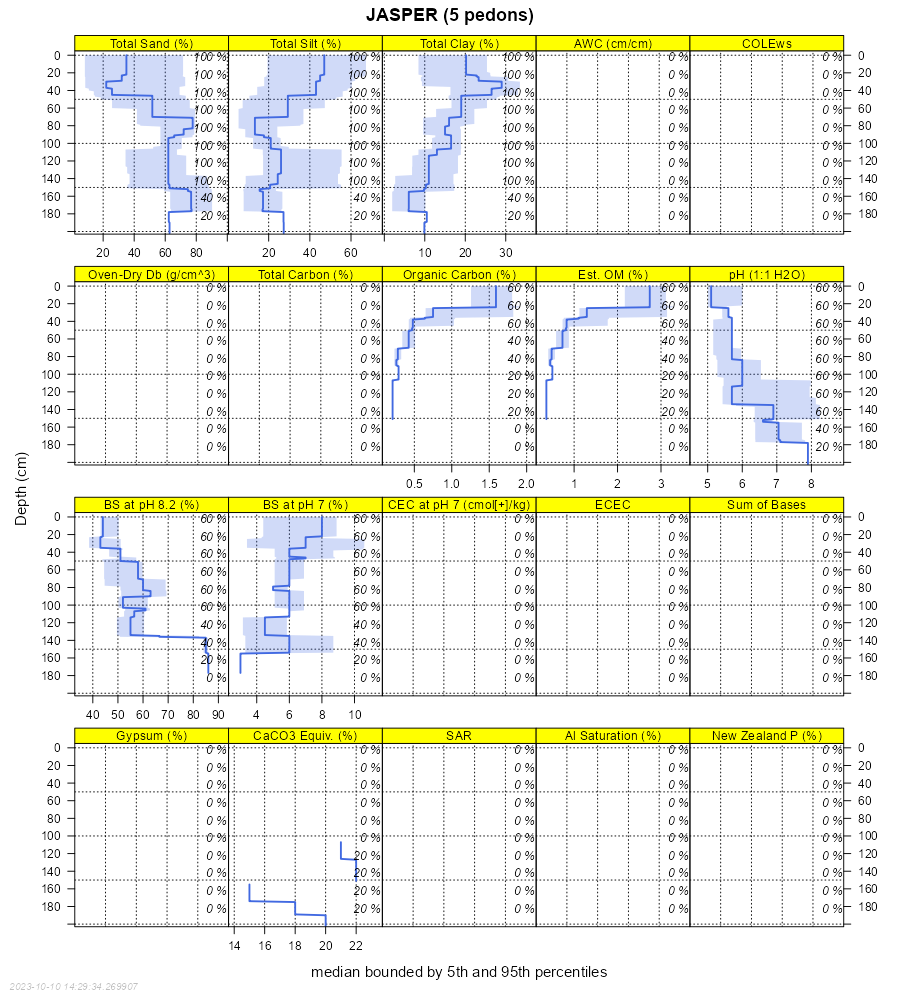| Jasper silt loam, 2 to 5 percent slopes | 440B | 2605 | 199847 | 6pyp | il007 | 2006 | 1:12000 |
Jasper silt loam, 0 to 2 percent slopes | 440A | 1415 | 199846 | 6pyn | il007 | 2006 | 1:12000 |
Jasper silt loam, 5 to 10 percent slopes, eroded | 440C2 | 323 | 1483183 | 1lscm | il007 | 2006 | 1:12000 |
Jasper silt loam, 0 to 2 percent slopes | 440A | 1138 | 1862744 | 20jbj | il011 | 2007 | 1:12000 |
Jasper silt loam, 2 to 5 percent slopes | 440B | 721 | 1862745 | 20jbk | il011 | 2007 | 1:12000 |
Jasper loam, 5 to 10 percent slopes, eroded | 440C2 | 1 | 1862905 | 20jhq | il011 | 2007 | 1:12000 |
Jasper fine sandy loam, 5 to 10 percent slopes, eroded | 440C2 | 294 | 175201 | 5w9n | il067 | 1993 | 1:15840 |
Jasper loam, 2 to 5 percent slopes, rarely flooded | 7440B | 254 | 2604126 | 2r798 | il067 | 1993 | 1:15840 |
Jasper loam, 2 to 5 percent slopes | 440B | 203 | 175200 | 5w9m | il067 | 1993 | 1:15840 |
Jasper loam, 2 to 5 percent slopes | 440B | 3649 | 175580 | 5wpw | il075 | 1980 | 1:15840 |
Jasper loam, 0 to 2 percent slopes | 440A | 3611 | 988877 | 12608 | il091 | 2003 | 1:12000 |
Jasper loam, 2 to 5 percent slopes | 440B | 2188 | 977646 | 11t9z | il091 | 2003 | 1:12000 |
Jasper loam, 5 to 10 percent slopes, eroded | 440C2 | 136 | 977648 | 11tb1 | il091 | 2003 | 1:12000 |
Jasper loam, 2 to 5 percent slopes | 440B | 6426 | 921374 | zxrr | il103 | 2004 | 1:12000 |
Jasper loam, 0 to 2 percent slopes | 440A | 1909 | 921373 | zxrq | il103 | 2004 | 1:12000 |
Jasper loam, 5 to 10 percent slopes, eroded | 440C2 | 1015 | 921375 | zxrs | il103 | 2004 | 1:12000 |
Jasper loam, 2 to 5 percent slopes | 440B | 2332 | 176976 | 5y4x | il105 | 1991 | 1:15840 |
Jasper loam, 0 to 2 percent slopes | 440A | 1800 | 176975 | 5y4w | il105 | 1991 | 1:15840 |
Jasper loam, 5 to 10 percent slopes, eroded | 440C2 | 335 | 176977 | 5y4y | il105 | 1991 | 1:15840 |
Jasper loam, 2 to 5 percent slopes | 440B | 16900 | 208631 | 7031 | il141 | 2005 | 1:12000 |
Jasper loam, 0 to 2 percent slopes | 440A | 6519 | 208630 | 7030 | il141 | 2005 | 1:12000 |
Jasper loam, 5 to 10 percent slopes, eroded | 440C2 | 2400 | 208632 | 7032 | il141 | 2005 | 1:12000 |
Jasper silt loam, 0 to 2 percent slopes | 440A | 4 | 2650830 | 2r20w | il155 | 1987 | 1:15840 |
Jasper loam, 0 to 2 percent slopes | 440A | 1908 | 1601068 | 1qr1c | il183 | 2006 | 1:12000 |
Jasper loam, 2 to 5 percent slopes | 440B | 994 | 1601069 | 1qr1d | il183 | 2006 | 1:12000 |
Jasper loam, 5 to 10 percent slopes, eroded | 440C2 | 206 | 1601070 | 1qr1f | il183 | 2006 | 1:12000 |
Jasper loam, 2 to 5 percent slopes | 440B | 2314 | 210880 | 72fl | il197 | 2002 | 1:12000 |
Jasper loam, 5 to 10 percent slopes, eroded | 440C2 | 649 | 210881 | 72fm | il197 | 2002 | 1:12000 |
Jasper loam, 0 to 2 percent slopes | 440A | 499 | 210879 | 72fk | il197 | 2002 | 1:12000 |
Jasper silt loam, 2 to 5 percent slopes | 440B | 7384 | 174099 | 5v53 | il201 | 1997 | 1:12000 |
Jasper silt loam, 0 to 2 percent slopes | 440A | 4686 | 174098 | 5v52 | il201 | 1997 | 1:12000 |
Jasper silt loam, 5 to 10 percent slopes, eroded | 440C2 | 1008 | 174100 | 5v54 | il201 | 1997 | 1:12000 |
Jasper silt loam, 0 to 2 percent slopes | 440A | 855 | 869226 | y5hk | il203 | 2008 | 1:12000 |
Jasper silt loam, 5 to 10 percent slopes, eroded | 440C2 | 242 | 869228 | y5hm | il203 | 2008 | 1:12000 |
Jasper silt loam, 2 to 5 percent slopes | 440B | 137 | 869227 | y5hl | il203 | 2008 | 1:12000 |
Jasper silt loam, till substratum, 2 to 6 percent slopes | JaB | 765 | 163018 | 5gmn | in107 | 1984 | 1:15840 |
Jasper fine sandy loam, sandy substratum, 1 to 5 percent slopes | 64021 | 339 | 888734 | ytsv | mo045 | 1992 | 1:24000 |
Jasper loam, 1 to 7 percent slopes | 64022 | 1636 | 888789 | ytvm | mo111 | 1986 | 1:24000 |
Jasper loam, 2 to 6 percent slopes | 7440B | 1013 | 426321 | g9m9 | wi105 | 1970 | 1:20000 |
Jasper loam, 0 to 2 percent slopes | 7440A | 948 | 426320 | g9m8 | wi105 | 1970 | 1:20000 |














